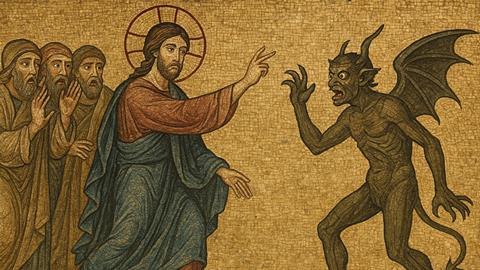Did Jesus cast out demons as a miracle-working prophet - or was he seen as a sorcerer by his critics? While early opponents didn’t deny his extraordinary deeds, they debated the source of his power. Today, historians across worldviews widely agree: in his own time, Jesus was famously known as an exorcist. Discover why this reputation matters for understanding his identity, mission, and the historical roots of the gospel story.
From the pagan philosopher Celsus to later rabbinic commentary, some of the earliest critics of Christianity didn’t deny that Jesus performed extraordinary deeds – they challenged the source of his power. Yet today, historians across the belief spectrum agree that Jesus was widely known as an exorcist in his own lifetime. So what led to this reputation, and why does it matter for how we understand Jesus’ mission and identity?
Celsus, moreover, unable to resist the miracles which Jesus is recorded to have performed, has already on several occasions spoken of them slanderously as works of sorcery.’ – Origen, Against Celsus 2.48 1
In the second century, the pagan philosopher Celsus launched a full-blown critique of a burgeoning Jewish sect known as Christianity. Clearly, his critique hit enough of a nerve that Origen, a theologian of the following century, felt it was due a response.
In the passage quoted above, we find the accusation that Jesus was a “sorcerer.” For Celsus, it was by the dark arts that Jesus learnt in Egypt as a child that he was able to work wonders and lead people astray. 2 There was no denying that Jesus was an exorcist. What was debatable was the power by which Jesus performed his deeds.
The notion that Jesus was a sorcerer was one with enduring appeal to Christianity’s critics. In a later rabbinic commentary on Jesus’ death, we find the same motif:
‘On the eve of Passover, they hanged Jesus the Nazarene. And a herald went out before him for forty days, saying: ‘He is going to be stoned, because he practised sorcery and enticed and led Israel astray. Anyone who knows anything in his favour, let him come and plead on his behalf.’ But, not having found anything in his favour, they hanged him on the eve of Passover.’ – B. Sanhedrin 43a 3
Like the critique from Celsus, there was no denying that Jesus was a worker of miraculous deeds. The only question was the motive and power of those same actions.
Today, in mainstream scholarship, I would argue that the situation is not so different from our ancient texts. Many scholars of differing worldviews would question whether Jesus was actually casting out demons by the power of Israel’s God. Yet the idea that Jesus was in his lifetime considered an exorcist is not in serious doubt.
Read more:
Does science prove God?
How we all came to think science and religion were at war
Atheism and the ignorance of science
How can churches embrace science?
Consider the following statements from a sample of Jesus historians:
- Bart Ehrman: “So abundantly attested are Jesus’ miracle-working abilities that even scholars who are otherwise sceptical of the supernatural biases of our sources sometimes claim that whatever else one can say about him, Jesus was almost certainly a healer and an exorcist.” 4
- Gerd Theissen & Annette Merz: “… we must assume not only that the historical Jesus was active as an exorcist but also that exorcism was of great importance for his understanding of himself.” 5
- Graham Twelftree: “… exorcism was one of the most obvious and important aspects of his ministry, both from the perspective of Jesus and the later Gospel writers. Therefore, to sketch a picture of the historical Jesus without significant reference to his ministry of exorcism is to produce a distortion of the evidence.” 6
Why Jesus was an Exorcist
The question I want to address in this piece is: why? Why is it that virtually all historians today – whether or not they think that demons were actually cast out by Jesus – believe that Jesus was perceived as an exorcist during his lifetime?
1. Messianic expectations
One very good reason to think Jesus was an exorcist is that there was no expectation that a coming messianic figure would perform exorcisms. This means that if the early Jesus followers were inventing stories to fit a messianic profile, they would not naturally come up with the idea that Jesus was an exorcist.
At one point in his ministry, John the Baptist harbours doubts as to whether Jesus really was a messianic figure. And Jesus offers him this reply:
‘Go back and report to John what you have seen and heard: The blind receive sight, the lame walk, those who have leprosy are cleansed, the deaf hear, the dead are raised, and the good news is proclaimed to the poor.’ (Luke 7:22)
Notice that the miracles here correspond to a list of signs from Isaiah, which were perceived in Jesus’ time in relation to the messiah. One text from the Dead Sea Scrolls, the so-called ‘Messianic Apocalypse,’ explicitly brings these signs into connection with mashiach. Yet exorcisms are not among them.
This may be why John completely guts his gospel of exorcisms, despite being aware of Jesus’ exorcist activities. 7 John says that he narrates the signs he does so that you may believe that Jesus is the Christ, the Son of God.’ Yet exorcisms were not seen as a trait of the messiah. Exorcisms did not fit John’s purpose in writing his gospel.
2. An Abundance of Sources
Another strong piece of evidence that Jesus was an exorcist is the sheer volume of exorcism stories in the gospels. Familiarity with these stories can mask the fact that there was no antiquity who is known to have attracted as many exorcism stories as Jesus.
The sources for Jesus’ exorcism are varied. Exorcisms first appear in Mark, which alone contains more exorcisms than any other biographical narrative. 8 Several of these stories are taken up in Matthew and Luke, but exorcism is also independently attested in ‘Q’, a source which many scholars believe lies behind Matthew and Luke. 9 Exorcisms are also assumed in the disciples’ mission and a series of brief reports. 10
Note then that Jesus’ exorcistic activity does not depend upon the reliability of any single story. Even if the gospel stories represent an expansion of episodes in Jesus’ life or an invention of the early Church, one is hard-pressed to credit all of the exorcism traditions to the ecclesiastical period. If even two of the many sources in the gospels reflect Jesus, the historical figure, we can view him as an exorcist.
3. His Enemies Thought So
One fascinating aspect of this evidence is that even Jesus’ enemies thought he was an exorcist. Here, I am not referring to Celsus and later rabbinic literature, which are secondary to the Gospels. Rather, I am referring to the early claim of Jesus’ opposition that he had ‘cast out demons by the ruler of demons’ (Mt. 9:34).
Note that at this stage, Jesus’ opponents do not deny that he was exorcising – an obvious point to make if Jesus’ exorcistic activity was merely hearsay. Rather, they simply question the power by which he performed exorcisms. This is some evidence that Jesus was not only an exorcist, but that he was also perceived as successful.
Get access to exclusive bonus content & updates: register & sign up to the Premier Unbelievable? newsletter!
4. Exorcism was not uncommon
A further reason to suppose that Jesus was an exorcist is that it fits the beliefs and practices of his time. One ‘patron’ of the Jewish exorcism tradition was Solomon, who was alleged to have expelled demons and left behind his modus operandi.
Consider this story, narrated by the first-century Jewish historian, Josephus:
‘And this kind of cure [of Solomon] is of very great power among us to this day, for I have seen a certain Eleazar, a countryman of mine, in the presence of Vespasian, his sons, tribunes and several other soldiers, free men possessed by demons, and this was the manner of the cure: he put to the nose of the possessed man a ring which had under its seal one of the roots prescribed by Solomon, and then, as the man smelled it, drew out the demon through his nostrils, and, when the man at once fell, adjured the demon never to come back into him, speaking Solomon’s name and reciting the incantations which he had composed.’ 11
Josephus goes on to describe how Eleazar placed a ‘cup or foot-basin full of water a little way off and commanded the demon, as it went out of the man, to overturn it and make known to the spectators that he had left the man.’ This is redolent of Jesus’ exorcism of ‘Legion’ from a person into some particular location – a herd of pigs.
Even during his lifetime, Jesus was not alone in exorcising demons. His disciples also embarked on a ministry of exorcism, as well as people who were not connected directly to Jesus. As Luke says, ‘John answered, ‘Master, we saw someone casting out demons in your name, and we tried to stop him, because he does not follow with us.’
After Jesus’ ministry, the practice of exorcising in Jesus’ name continued. Acts 17 reports that the sons of a Jewish priest called Sceva were exorcising in his name. We also find in the late second or early third century an amulet which shows the crucified Jesus. The words ‘Son, Father, Jesus Christ appear on the front, alongside a series of impenetrable syllables, perhaps indicating some kind of magical use 12
Exorcisms were also a common part of the wider Graeco-Roman world. The Greek Magical Papyri is an important historical source attesting to exorcistic and magical beliefs, preserving spells, rituals and recipes from the second to the fifth century Egypt 13 One fragmented instruction manual even explains to appeal to the name of Jesus: “I adjure you by the God of the Hebrews, Jesus IABA… who appears in fire… !”14
These give us a glimpse into a world in which exorcism was not considered unusual. In fact, if anything, it is secular cultures which are unusual in not believing in these phenomena. Craig Keener has surveyed the anthropological literature, showing that belief in spirits and deliverance from them is widespread across cultures. 15 Jesus’ own exorcist ministry fits not only his setting but also broader human experience.
5. Jesus’ Exorcisms were Distinctive
We have seen that exorcisms fit well into the specific context of Jesus’ ministry, as well as the more general practice of the Graeco-Roman world. Yet it is striking that Jesus does not simply mirror the wider exorcist practices of his time. The stories about Jesus’ exorcism show that his activity was distinctive, in at least three ways..
One distinctive aspect of Jesus’ ministry is the means by which he exorcises. As we have seen in Josephus’ story of Solomon and Eleazar and the Greek Magical Papyri, other exorcists would often use objects or incantations in their exorcisms. Yet Jesus does not require objects or spells. He simply commands the demons to be gone.
Another distinctive aspect of Jesus’ ministry is the authority by which he exorcises demons. In the case of the Sons of Sceva and other exorcists during his ministry, we find people attempting exorcism in Jesus’ name. Yet Jesus does not perform exorcisms by invoking someone else’s name. He does it directly by the ‘finger’ of God (Lk. 11:20).
Finally, Jesus is distinctive in the interpretation he gives to exorcisms. He sees them, unusually, as evidence of the arrival of God’s kingdom. This tallies well with his experience of seeing Satan as ‘fall like lightning’ (Lk. 10:8). It also lines up with what we know about end-time expectations in which Satan would be overthrown.
That Jesus’ exorcist activity is distinctive is historically significant. It suggests that the stories of Jesus were not simply copied and pasted from other historical figures. Rather, Jesus had a unique approach, as well as a unique success, with exorcism.
Jesus the Exorcist
To take stock, we have looked at five reasons to think that Jesus was an exorcist: (1) the lack of messianic expectations around exorcism; (2) the abundances of sources for his exorcist activity; (3) the fact that even his enemies seem to have thought that he was an exorcist; (4) the plausibility of exorcism within his world; and (5) his distinctive approach.
For these reasons and more, virtually all historians today agree that Jesus was an exorcist. Of course, scholars will disagree on what was really going on in those encounters – how one interprets the data will be shaped by one’s philosophical commitments. Yet to claim that Jesus was an exorcist is not to commit oneself to every meta-normal detail in the gospels. It is simply to follow the evidence where it leads.
Dr John Nelson is a host of the Premier Unbelievable? podcast, he teaches Theology & Philosophy at Haberdashers’ Boys’ School, writes Behind the Gospels and is Producer & Researcher of the history podcast, Biblical Time Machine. His revised PhD thesis at the University of Edinburgh is forthcoming as Jesus’ Physical Appearance: Biography, Christology and Philosophy (2025)
Further Reading
Twelftree, Graham H. Jesus the Exorcist: A Contribution to the Study of the Historical Jesus, WUNT 2.54. Tübingen: Mohr Siebeck, 1993.
1 Quotations of Origen are taken from Frederick Crombie’s translation of the Ante-Nicene Fathers, vol. 4, eds. by Alexander Roberts, James Donaldson, and A. Cleveland Coxe. (Buffalo, NY: Christian Literature Publishing Co., 1885), revised and edited for New Advent by Kevin Knight. Available online: https://www.newadvent.org/fathers/0416.htm.
2 See Origen, Contra Celsum, 1.38.
3 Cited in Craig A. Evans, New Testament Studies: A Guide to the Background Literature (Grand Rapids, MI: Baker Academic, 2005), 251. Cf. t. Sanh. 10.11; y. Sanh. 7.12; Tg. Esth. I 7:9.
4 Bart Ehrman, “Was Jesus Considered a Miracle Worker During His *Lifetime*?” Bart Ehrman Blog, 3rd December 2023. Accessed Wednesday 29th October: https://ehrmanblog.org/was-jesus-considered-a-miracle-worker-during-his-lifetime/. Ehrman himself is in the “minority” in being sceptical of the miracle-working tradition, in part due to his model of the traditioning process. For a critique of his model, see Alan Kirk, “Ehrman, Bauckham and Bird on Memory and the Jesus Tradition,” JSHJ, 15 (2017): 88-114, summarised on “Bart Ehrman’s ‘Telephone Game’” Behind the Gospels, 27th April 2024.
5 Gerd Theissen, Annette Merz, The Historical Jesus: A Comprehensive Guide (Minneapolis: Fortress Press, 1996), 292-293.
6 Graham H. Twelftree, Jesus the Exorcist: A Contribution to the Study of the Historical Jesus, WUNT 2.54 (Tübingen: Mohr Siebeck, 1993), 225.
7 See my piece, “Why No Exorcisms in John?” Behind the Gospels, 28th October, 2025.
8 See Mk. 1:21–28; Mk, 5:1–20; Mk. 7:24–30; Mk. 9:14–29.
9 See Mt. 12.22-3/Luke 11.14. For a a classic critique of the ‘Q’ hypothesis, see Mark Goodacre, The Case Against Q: Studies in Markan Priority and the Synoptic Problem (Harrisburg, Pa: Trinity Press, 2002).
10 On the disciples’ mission: Mk. 6.7-12,30/Mt. 10.1 -15/Lk. 9.1-6; 10.1-11, 17-20. On the summary reports, see Mk. 1.32-4/Mt 8.16–17; Lk 4.40–41; Mk. 1.39/Mt. 4:23-24; Mk. 3.7-12/Mt. 12:15-16/Lk. 6:17-19.
11 Josephus, Antiquities 8.45-48 (LCL)
12 See Felicity Harley-McGowan, “The Constanza Carnelian and the Development of Crucifixion Iconography in Late Antiquity” in ‘Gems of Heaven’: Recent Research on Engraved Gemstones in Late Antiquity, c. AD 200-600, eds. Chris Entwistle and Noël Adams. British Museum Research Publication 117 (London: The Great British Museum), 214-220.
13 For the texts in English translation, see Hans Dieter Betz (ed) The Greek Magical Papyri in Translation, Including the Demotic Spells. 2nd ed. (Chicago: University of Chicago Press, 1992).
14 Naomi Janowitz, Magic in the Roman World: Pagans, Jews and Christians (London: Routledge, 2001), 41.
15 See Craig S. Keener, “Appendix B: Spirit Possession and Exorcisms in Societies Today” in Miracles: The Credibility of the New Testament Accounts (Grand Rapids, MI: Baker Academic, 2011), 788-856.























